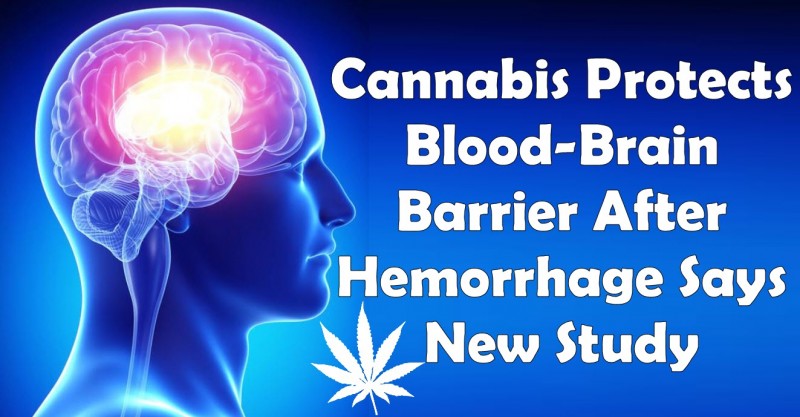Cannabis Protects Blood-Brain Barrier After Hemorrhage Says New Study
How Cannabis Protects the Blood Brain Barrier from CannabisNet on Vimeo.
Hemorrhage is a medical term that describes bleeding and blood loss within (internal bleeding) or outside (external bleeding) of the body. It can affect any part of the body, but internal bleeding arises after blood leaks from a damaged organ or blood vessel.
A brain hemorrhage is a type of internal bleeding, characterized by bleeding around and in the brain. Causes of brain hemorrhages include drug abuse, high blood pressure, weak blood vessels, and brain trauma. However, elevated blood pressure is the leading cause of brain hemorrhage. People with a brain hemorrhage may feel as though a stroke is occurring, and this can lead to weakness on either side of the body, numbness, and difficulty speaking.
There are different types of brain hemorrhage: intracranial hemorrhage refers to bleeding anywhere within the skull, while bleeding inside the brain itself is called intracerebral hemorrhage. Brain bleeding that occurs between the brain tissue and the covering of the brain is called as subarachnoid hemorrhage.
Hemorrhages, as well as strokes, can lead to extreme damage to the blood-brain barrier. When this happens, it increases the risk of more serious long-term effects because a damaged blood-brain barrier can no longer protect the brain from blood-borne material, resulting in cellular death and permanent movement and cognitive impairments which are commonly seen among stroke patients.
Now, new research reveals that cannabis can help protect the blood-brain barrier after hemorrhage.
The study, which was published in the journal Brain Research, showed that cannabinoids in the cannabis plant help mitigate neuroinflammation while protecting the blood-brain barrier after an intracerebral hemorrhage.
“The blood-brain barrier (BBB) disruption and the following development of brain edema, is the most life-threatening secondary injury after intracerebral hemorrhage (ICH),” says the abstract. “This study is to investigate a potential role and mechanism of JWH133, a selected cannabinoid receptor type2 (CB2R) agonist [meant to mimic the effects of natural cannabinoids], on protecting blood-brain barrier integrity after ICH.”
The researchers used 192 adult male rats for the study, who were randomly divided into several groups. They were then given different doses of CB2 agonists, or none at all. The scientists found that the agonist “ameliorated brain edema, neurological deficits and blood-brain barrier damage, as well as microglia activation,” as well as other significant positive changes.
The study concluded stating that “CB2R agonist alleviated neuroinflammation and protected blood-brain barrier permeability in a rat ICH model.”
Cannabis Helps Brain Injury Patients
This study builds on a few but promising older studies showing that cannabis is beneficial for helping brain injury patients recover.
A previous study published in the journal Cerebrovascular Diseases reveals that cannabis reduces the severity and improves the recovery time among patients who suffered from hemorrhage. The international scientists conducted a study of 725 people who suffered from intracerebral hemorrhaging. Their patient outcomes and demographic patterns were analyzed as well. They found that the patients who consumed medical cannabis were shown to exhibit less severe symptoms and were able to recover faster.
Additionally, a 2014 study conducted by UCLA showed that brain injury patients who consumed cannabis had higher survival rates. “Researchers reported that cannabis-positive subjects possessed ‘milder ICH’ presentation upon hospitalization and presented ‘less disability’ at discharge as compared to similarly matched patients who tested negative for cannabinoids,” reads the study.
A 1998 study, published in Proceedings of the National Academy of Sciences, discovered that cannabidiol (CBD) and tetrahydrocannabinol (THC), the two major cannabinoids found in cannabis, offer substantial protection to the brain from the damage caused by strokes. The animal study concluded that CBD is “a better candidate” for stroke victims for recovery because of the absence of any psychoactive effects. It also revealed that cannabinoids help inhibit the production of a neurochemical known as glutamate, which causes the accumulation of harmful oxidizing molecules that result in brain cell death. Glutamate is produced when our brains lack oxygen, which is a common occurrence following arterial hemorrhage or a blood clot. It even says that CBD is a more powerful antioxidant compared to vitamins A and E, both of which are also known to protect the brain from damage caused by glutamate.
Have you used cannabis to recover from hemorrhages or a brain injury? Share your experience with us in the comments below.
Marijuana Protects Blood-Brain Barrier After Hemorrhage Says New Study from CannabisNet on Vimeo.
OTHER STORIES YOU MAY ENJOY...
CANNABIS FOR BRAIN INJURIES, TBI, HAS STARTED, CLICK HERE.








